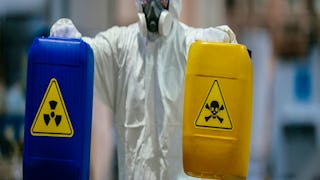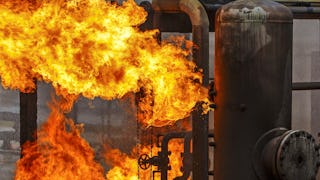Discover the core principles of process safety and risk analysis in chemical engineering through our dynamic course. Gain expertise in modeling liquid and gas leaks, accurately assessing potential material releases, and calculating downwind exposures to toxic chemicals using state-of-the-art dispersion models. This course equips chemical engineers with essential skills to evaluate and mitigate hazardous concentrations effectively, ensuring industrial process safety. From theoretical foundations to practical applications, participants will learn to propose prevention measures and advance their careers in chemical engineering. Join us to elevate your proficiency in process safety and make a meaningful impact in the field.

Gain next-level skills with Coursera Plus for $199 (regularly $399). Save now.

Predictive Models for Toxic Chemical Releases
This course is part of Chemical Hazards and Process Safety Specialization

Instructor: Jason White
2,502 already enrolled
Included with
(54 reviews)
Skills you'll gain
Details to know

Add to your LinkedIn profile
4 assignments
See how employees at top companies are mastering in-demand skills

Build your subject-matter expertise
- Learn new concepts from industry experts
- Gain a foundational understanding of a subject or tool
- Develop job-relevant skills with hands-on projects
- Earn a shareable career certificate

There are 4 modules in this course
After this module, you will be able to describe the terms that make up the mechanical energy balance. You will be able to apply the mechanical energy balance to derive a simple source model for a liquid leak through a hole and be able to extend the simple source model for liquid leak through a hold to account for a situation where the change in liquid level is significant. You will also be able to incorporate frictional losses in piping systems into liquid source model derivation.
What's included
9 videos4 readings1 assignment1 discussion prompt
After this module, you will be able to apply the mechanical energy balance to derive a simple source model for a gas leak through a hole. You will also be able to use models of adiabatic and isothermal gas or vapor flows through pipes and understand challenges with deriving models for such flows. You will be able to estimate volatile vapor component concentrations in enclosed spaces and assess the potential for hazardous concentrations and be able to describe source model selection for scenarios involving flashing liquids.
What's included
8 videos4 readings1 assignment1 discussion prompt
After this module, you will be able to describe air dispersion and the parameters required to describe it. You will be able to formulate neutrally buoyant plume dispersion models. You'll also be able to perform calculations using plume models and use results to identify potential hazardous situations and propose prevention/mitigation measures if necessary.
What's included
6 videos2 readings1 assignment
After this module, you will be able to formulate neutrally buoyant puff models and be able to describe isopleths and how they are used in evaluating puff models. You will be able to perform calculations using puff models and use results to identify potential hazardous situations and propose prevention/mitigation measures if necessary.
What's included
7 videos4 readings1 assignment1 discussion prompt
Earn a career certificate
Add this credential to your LinkedIn profile, resume, or CV. Share it on social media and in your performance review.
Instructor

Offered by
Explore more from Chemistry
 Status: Free Trial
Status: Free TrialUniversity of California, Davis
 Status: Free Trial
Status: Free TrialUniversity of California, Davis
 Status: Free Trial
Status: Free TrialUniversity of California, Davis
 Status: Free Trial
Status: Free TrialUniversity of California, Davis
Why people choose Coursera for their career




Learner reviews
54 reviews
- 5 stars
62.96%
- 4 stars
31.48%
- 3 stars
5.55%
- 2 stars
0%
- 1 star
0%
Showing 3 of 54
Reviewed on Jan 20, 2025
Very interesting, found the math quite hard but the theory made sense and was very worthwhile.
Reviewed on Oct 4, 2024
The course is useful in day-to-day activities and process safety concern.
Frequently asked questions
To access the course materials, assignments and to earn a Certificate, you will need to purchase the Certificate experience when you enroll in a course. You can try a Free Trial instead, or apply for Financial Aid. The course may offer 'Full Course, No Certificate' instead. This option lets you see all course materials, submit required assessments, and get a final grade. This also means that you will not be able to purchase a Certificate experience.
When you enroll in the course, you get access to all of the courses in the Specialization, and you earn a certificate when you complete the work. Your electronic Certificate will be added to your Accomplishments page - from there, you can print your Certificate or add it to your LinkedIn profile.
Yes. In select learning programs, you can apply for financial aid or a scholarship if you can’t afford the enrollment fee. If fin aid or scholarship is available for your learning program selection, you’ll find a link to apply on the description page.
More questions
Financial aid available,





